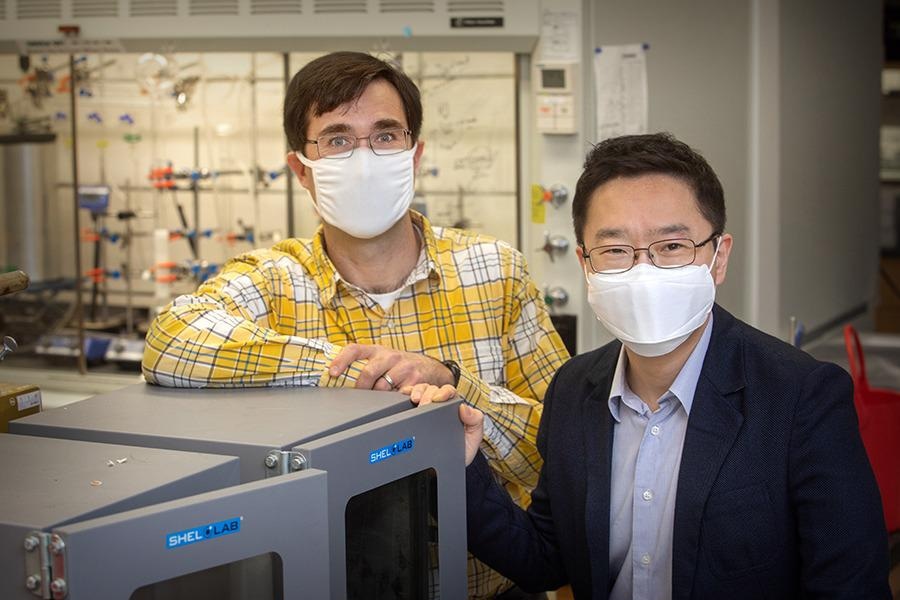Feb 23 2021
A group of researchers from Florida State University (FSU) has devised a new method to make use of a material contained in plants to develop safer batteries.
 From left, FAMU-FSU College of Engineering associate professor Daniel Hallinan Jr. and FAMU-FSU College of Engineering assistant professor Hoyong Chung. Their research developed a way to use lignin, a compound in the cell walls of plants that makes them rigid, in the electrolytes of batteries. Image Credit: Florida State University Photography Services.
From left, FAMU-FSU College of Engineering associate professor Daniel Hallinan Jr. and FAMU-FSU College of Engineering assistant professor Hoyong Chung. Their research developed a way to use lignin, a compound in the cell walls of plants that makes them rigid, in the electrolytes of batteries. Image Credit: Florida State University Photography Services.
The researchers used an organic polymer called lignin—a compound present in the cell walls of plants that makes them stiff—and could create battery electrolytes. The study was published as the cover article in the Macromolecular Rapid Communications journal.
The main battle in battery science is in new materials. Depending on what kind of material we use, we can improve the capacity of the battery and the safety of the battery substantially.
Hoyong Chung, Study Corresponding Author and Assistant Professor of Chemical and Biomedical Engineering, FAMU-FSU College of Engineering
The researchers developed their new kind of solid electrolyte by combining lignin with the synthetic polymer polyethylene glycol.
In a battery, electrolytes form one of the parts and isolate the positive terminal of the battery from the negative terminal.
They conduct ions that correspond with the flow of electrons moving from the negative to the positive terminal and via whatever the battery is meant to power.
Electrolytes can be in the form of solid or liquid, and each type has its own weaknesses and strengths.
While liquid electrolytes are known to be good conductors of ions, solid electrolytes are essentially stronger, safer, and can be utilized at higher temperatures compared to liquid ones.
Although polyethylene glycol is a famous candidate for solid electrolytes due to its electrochemical stability, it fails to perform well at room temperature, which restricts the capabilities of batteries based on that material to power something or to quickly charge.
That is exactly where lignin has a role to play.
The chemical structure of lignin comprises high concentrations of derivatives that come from a compound known as benzene, making it a robust material. When lignin is used as an electrolyte component, the battery retains the safety and strength that is provided by a usual solid electrolyte but gains the potential to function well at ambient temperature.
Besides increasing the temperature range at which a solid electrolyte battery is viable, the use of lignin is a method to make batteries last longer.
Lignin is cost efficient and plentiful, with nearly 50 million tons produced annually worldwide. A major portion of that is a waste product obtained from the paper industry. In contrast to other biomass materials, it is not a human food and cannot be used otherwise to feed people.
This is a way to improve battery performance and to do so in a sustainable way. Batteries will be even more important in the future, so improving their technology is crucial.
Hoyong Chung, Study Corresponding Author and Assistant Professor of Chemical and Biomedical Engineering, FAMU-FSU College of Engineering
Daniel Hallinan Jr, FAMU-FSU College of Engineering associate professor and co-corresponding author; former graduate student Hailing Liu; and former graduate assistant Logan Mulderrig contributed to this study.
This study was supported by the National Science Foundation and Florida State University’s Energy and Materials Hiring initiative.
Journal Reference:
Liu, H., et al. (2020) Lignin‐Based Solid Polymer Electrolytes: Lignin‐Graft‐Poly(ethylene glycol). Macromolecular Rapid Communications. doi.org/10.1002/marc.202000428.